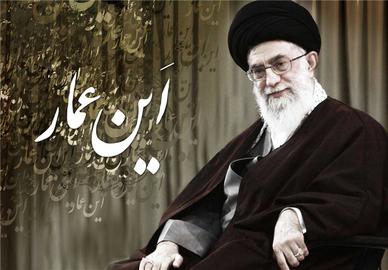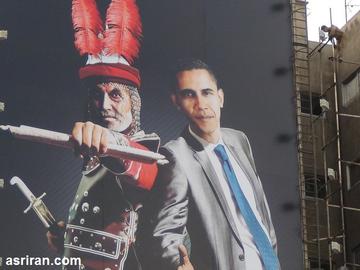In the political terminology of the Islamic Republic of Iran, there are many references to the history of Islam, and Shia Islam in particular. Many of these references are made, often by hardliners, to compare today’s personalities with specific iconic figures in the history of Islam and Shia Islam.
This article will briefly explain some important references of this kind, as well as their political implications, and provide a few examples of the manner in which they have been used as metaphors or similes in Iran’s political discourse.
Abu Jahl, Abu Sufyan and Abu Lahab
His real name was Amr Ibn Hisham, but this tribe leader was famous as Abu Jahl, which means “father of ignorance.” Abu Jahl was one of the leaders of the ruling Quraysh tribe in Mecca, and one of staunchest and fiercest enemies of Muslims in the early years of Islam. He was against any compromise with the Prophet Muhammad and plotted to kill him.
In the political discourse of the Islamic Republic, Abu Jahl has become a metaphor that refers to those enemies of the Islamic Republic, in particular foreign enemies such as the United States or Saudi Arabia, that wish to defeat it by force.
It was in the same context that Ayatollah Khamenei said on July 30, 2008: “Today’s Abu Jahls are those who make atomic bombs and threaten the entire world. Yet they pick on a nation that is trying to achieve nuclear energy, although they admit that this nuclear technology is to be used for generating electricity and for peaceful purposes. They want to stop us exactly because we intend to use the nuclear technology for peaceful purposes, which, they believe, will grant us further capabilities.”
In addition to Abu Jahl, Iran’s political literature also invokes other early leaders of the Quraysh when referring to powerful enemies of the Islamic Republic. Abu Lahab, one of the pagan uncles of the Prophet Muhammad, and Abu Sufyan, the most influential leader of the Quraysh, are famous examples of such Quraysh leaders.
Muawiyah
Muawiyah ibn Abu Sufyan was the governor of the Levant (Syria) during the rule of Ali, the first Shia Imam and the fourth caliph after the Prophet Muhammad’s death. Muawiyah refused to accept the caliphate of Ali, fought the Imam in the Battle of Siffin, and founded the Umayyad Caliphate.
In the political terminology of Iran, Muawiyah is the symbol of illegitimate power that strengthens its reign by means of force, money and deception. Iranian rulers may invoke Muawiyah as a metaphor for great powers such as the US.
For instance, Mohammad-Taghi Mesbah Yazdi, a pro-Khamenei ayatollah and a prominent hardline theoretician, wrote in his book Another Lightning in Karbala’s Sky, published in 2001: “The methods that Muawiyah adopted for reaching his objectives may be used by today’s powers, too. The inaction [of Ali’s followers] that took place in Muawiyah’s age may emerge more or less for the people of today. It is therefore necessary to examine why people were deceived, and why they were affected by the threats and briberies [of Muawiyah], so that we can resist when certain [others] try to deceive, threaten or bribe us.”
Malik al-Ashtar
Malik al-Ashtar was the commander of Imam Ali’s army in the Battle of Siffin. According to the Shias, at the end of the battle, Malik al-Ashtar was about to conquer Muawiyah’s headquarters (Muawiyah’s tent). But the Levant troops tied copies of the Koran to the ends of spears, demanding that the two parties stop the battle and resolve their disputes through “arbitration” (hakammyiat), which finally stabilized Muawiyah’s rule.
In the political literature of the Islamic Republic, Malik al-Ashtar is the symbol of a committed commander or politician who is always obedient to the Supreme Leader.
For example, on January 14, 2012, supporters of then-President Mahmoud Ahmadinejad welcomed him at the airport upon his return from a trip to Latin America, chanting: “Malik al-Ashtar of Ali, welcome back home!” In their slogan, Ali referred to Ali Khamenei, and Malik-al-Asthar referred to Mahmoud Ahmadinejad. In January 2012, Ahmadinejad had just started disobeying the Leader on certain issues, and by using the above slogan, his supporters implied that, in their view, the president was still obedient to the Leader.
Amr ibn al-As and Abu Musa Ash’ari
Amr ibn al-As was the main advisor to Muawiyah, the first Umayyad caliph, in particular during the Battle of Siffin. According to the Shias, at the end of the battle, Ali’s army was on the verge of victory, but Amr ibn al-As’s trickery changed the situation against the Shias’ favor. He ordered the Levant troops to demand that the two parties stop the battle and resolve their disputes through “arbitration” (hakamyyiat). As a result, the majority of Ali 's troops refused to continue the war and forced Imam Ali to appoint Abu Musa Ash’ari as his arbitrator to negotiate a peace agreement with Amr ibn al-As, Muawiyah’s appointed arbitrator. During the negotiations, Amr ibn al-As deceived Abu Musa Ash’ari so that the result of the arbitration stabilized Muawiyah’s rule in Levant, against Imam Ali’s will.
In the political discourse of the Islamic Republic of Iran, Amr ibn al-As is often the symbol of deception and plotting against the Leader, while Abu Musa Ash’ari is a metaphor for lacking intelligence and political insight.
An example where Abu Musa Ash’ari has been used as a metaphor is Keyhan newspaper’s reaction to various political figures who had suggested, on the eve of the 2013 presidential election, that the country needed a bipartisan president. An article published in Kayhan , whose managing director is appointed by the Leader, on August 16, 2012 said that those bipartisan politicians who had not condemned the post-2009 election protests were similar to Abu Musa Ash’ari: “Resorting to expressions such as bipartisanship after the 2009 sedition [the term conservatives use to refer to the unrest following the disputed presidential election that year] is similar to the logic adopted by those who preferred supporting a so-called moderate person such as Abu Musa Ash’ari rather than siding with the truth.”
An example of invoking Amr al-As to comment on modern political stances is the remarks made by Sayed Hamid Rouhani, the director of the Historical Research Foundation and the Islamic Republic Encyclopedia, on August 6, 2016. Likening Hassan Rouhani to Amr al-As, Sayed Hamid Rouhani said that the president should be tried for treason, adding: “While the Leader said there was no benefit in negotiating with the US, the Amr al-As’s of today forced the Leader to accept negotiations.”
Ammar
Ammar ibn Yasir was one of the closest companions of the Prophet Mohammed and the first Shia Imam, Ali. He was regarded as one of the most trusted commanders of Imam Ali, and played a decisive role in defending and propagating Ali’s views after Muhammad’s death. He was killed in the Battle of Siffin.
The hardline supporters of Iran’s Leader invoke Ammar as the symbol of insight, i.e., understanding correctly the Leader’s views and clarifying these views for others. They especially invoked Ammar for this purpose after the post-2009 election protests, when many politicians were accused of lacking insight because they did not condemn the protesters, or even sided with them. In the aftermath of this election, a group of influential hardliners even established an organization named the “Ammar headquarters” to confront the so-called insightless politicians and the enemies’ propaganda.
With regards to this view on Ammar’s role in the history of Shia Islam, Ayatollah Khamenei said on August 12, 2009: “Clarifying the realities is one of the most important things that our elites should do... During the Battle of Siffin, clarifying the realities was one of the most important duties of Ammar Yasir. That was because the opposing camp — that is, Muawiyah's camp — was making use of different forms of propaganda.”
Yazid and Shimr
In 680 AD, the third Shia Imam, Hossein, and a small group of his relatives and followers faced a large army dispatched by Yazid ibn Muawiah, the second Umayyad caliph. During the confrontation, named as the battle of Karbala or Ashura, Imam Hossein and 72 other Shias were killed because they chose to fight to the death rather than pledge allegiance to Yazid, whom they viewed as being an illegitimate ruler. The name of Imam Hossein’s killer was Shimr (or Shimr ibn Ziljushan).
In the Shia discourse, which has also been adopted in the Islamic Republic of Iran, Shimr and Yazid are the symbols of the brutality of the enemies of the Shias and the Muslims and of the atrocities these enemies carried out.
For instance, in November 2013, in the middle of the nuclear talks between Iran and the world powers, hundreds of billboards appeared across Iran, portraying the then-Us president as Yazid and Shemr. The billboards were part of an effort by organizations affiliated with the Islamic Revolutionary Guard Corps to transform the mourning day of Imam Hossein, Ashura, into a reason to oppose the upcoming nuclear deal.
On one of these billboards, Barak Obama was cursed as “the Yazid of the time,” and was made to look as if he was using a bow to shoot an arrow (with Israel’s flag on it) toward a Palestinian child. In another billboard, Barak Obama was portrayed next to Shimr, while the latter was offering a compromise deal to Imam Hossein. Given that the Imam rejected that deal, this billboard was implying that the Rouhani government’s possible compromise with the US over the nuclear issue would go against the path of Imam Hossein.
Zaynab
Zaynab bint Ali was Imam Hossein’s sister. She accompanied him in the Battle of Karbala (Ashura) and lost most of her male relatives in the course of the battle. After Karbala, Yazid’s army took Zaynab and other surviving women and children to Levant as prisoners of war. In Yazid’s court, Zaynab delivered a heroic, fearless speech against the Umayyad caliph in his presence.
In Shia terminology, Zaynab is known as the “messenger of Karbala” and a symbol of religious female heroism. Iranian officials often invoke Zaynab as a metaphor for those women who are ready to sacrifice for the Islamic Republic.
On July 9, 2017, Altaf Ahmad, the first female reporter of an Iranian network who had been dispatched to Iraq to cover the operations of the Iraqi forces against ISIS, made headlines in Iranian official media outlets because she referred to Zaynab as her role model. Ahmad said in her first live report from Mosul: “Her Holiness Zaynab was the first female war reporter and we are just the graduates of her school.”
Hurr
Hurr (Hurr ibn Yazid al-Riyahi) was one the commanders of the Umayyad army that was dispatched to confront Imam Hossein and his followers and force them to pledge allegiance to Yazid, the second Umayyad caliph. However, on the day of the Battle of Karbala (Ashura), Hurr left the Umayyad army to join Imam Hossein. He was later killed in the battle.
In the Shia terminology, Hurr is the symbol of repentance. Iranian officials often use the metaphor of Hurr to refer to those enemies of the Iranian regime who change sides to join the Supreme Leader’s camp.
For example, a few months after the beginning of Mahmoud Ahmadinejad’s disobedience toward Ayatollah Khamenei, Mohammad-Taghi Mesbah Yazdi, the prominent hardline theoretician, took Ahmadinejad’s case as an example to elaborate how people could change sides after so many years. He said on June 7, 2011: “God granted man free will, so certain people such as Hurr may be repentant after a lifetime of guilt, while some may become deviant after a lifetime of piety and virtue.
Also read:
Decoding Iran's Politics: Early Islamic Compromises as Political Symbols
Decoding Iran's Politics: Early Islamic Battles as Political Symbols
visit the accountability section
In this section of Iran Wire, you can contact the officials and launch your campaign for various problems


























comments